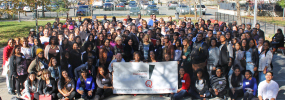
Support Queens Community House
Queens Community House provides individuals and families with the tools to enrich their lives and build healthy, inclusive communities.
[Our Executive Director Ben Thomases explains some of our history in the first part of this exclusive video: Queens Community House - 40 Years and Counting.]
In 1967, New York City Mayor John Lindsay announced a program of “scatter site housing,” the aim of which was to develop low-income housing projects in middle class neighborhoods. The concept was similar to that of the 19th century settlement house movement which held that some of the problems of poor ghettos could be alleviated by greater integration of the classes.
After an unsuccessful attempt to locate the project in Corona, a site was selected in nearby Forest Hills on the spot of a former golf range. A group of neighborhood residents mobilized against the proposal, using race and class stereotypes to play on fears of their neighbors. People picketed, engaged the support of some elected officials, and brought a lawsuit against the city. One angry resident even firebombed the site. Neighborhood supporters of the project and other elected officials, including the Mayor, held their ground, and the courts eventually approved development of the site.
Mayor Lindsay appointed a then little-known Queens attorney named Mario Cuomo to mediate the tensions that remained in the community, with the goal of moving the project forward peacefully. A compromise agreement was developed which reduced the size of the buildings, gave existing community residents priority to the units, set aside 40% of apartments for older adults citizens, and made the development the first low-income public housing cooperative in the nation. (Cuomo later published the story in “Forest Hills Diary,” helping to launch his political career.) As a result of a proposal submitted by a committee of 50 civic organizations, led by the American Jewish Committee, plans for a community center were developed as part of the compromise.
In spring 1976, Forest Hills Community House opened its doors with three staff members and a board of directors comprised of community residents who had been on both sides of the conflict. From the beginning, our mission included bringing together the economically-, ethnically- and racially-diverse residents of our community. The center was to be a place where all could come together to enhance the capacity of their neighbors to help each other. The first programs were a children’s program and a summer day camp. Self Help, Inc. moved a senior center into the building (the center became a FHCH program in 1993). By 1980, the core components of what would become our three departments (Youth Services, Community Services, and Older Adult Services) were in place.
Over the years, Forest Hills Community House began operating programs in neighborhoods beyond its Forest Hills/Rego Park base, replicating its successful program model to meet the needs of other communities. In 2007, Forest Hills Community House changed its name to Queens Community House, reflecting its growth and its presence in multiple neighborhoods throughout the borough. As we’ve grown, we have maintained our focus on neighborhood strength through individual empowerment and community connection, adopting the lessons learned in Forest Hills to address the ever-changing needs of our city’s most diverse borough.

Queens Community House provides individuals and families with the tools to enrich their lives and build healthy, inclusive communities.